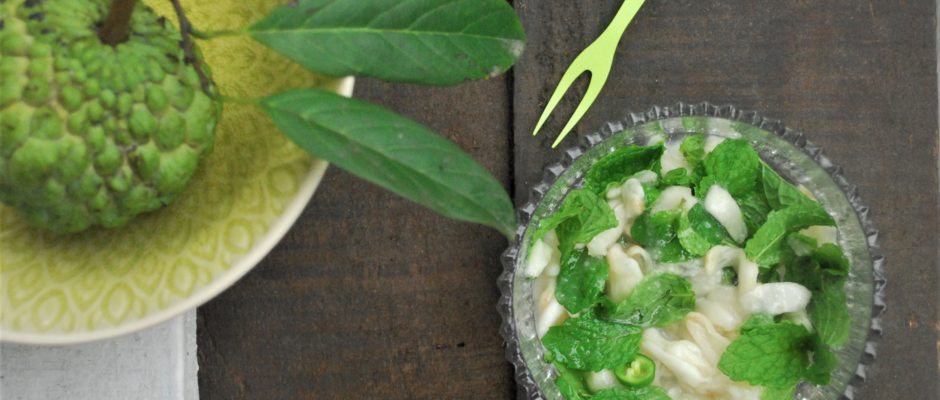Simplicity Coimbatore ,custard apples are in season

The custard apple trees at our home and farm are not very tall. I guess one could refer to it as a small tree. The branches grow thin and spindly almost like a bush in all directions.At the moment they are laden with fruit. Every time I open a custard apple,thoughts of my younger sibling making a meal out of it,when we were kids, comes rushing through my mind. Looking back it was almost as if those custard apples were kept aside just for him or maybe the rest of us were not as obedient when it came to eating fruit!


Thankfully today seasonal fruits form a major role in my diet and that of my family members. The other day ,at a get together with friends I was most surprised when someone woefully remarked that custard apples were her favourite fruit. I wondered at the dejected tone. When the conversation went on to talk of weight loss and diets,it struck me at how we have all gotten so conditioned to a western ideal of that which is healthy and that which is not !
Fortunately there is greater emphasis today on eating seasonal and local. The custard apple otherwise known as seethapazham or sitaphal in the vernacular is a fruit which grows in abundance locally in Coimbatore and many other parts of India.The season is approximately between August and October/November. It is laden with nutrients and minerals which are essential for our well being at this time of year. And yet what most of us (particularly women) tend to focus on is the calorie count and the natural sugar content. Whether the energy bar or protein shake we consume after a workout has preservatives etc or not doesn’t matter, but by all means let’s cut out the custard apple !
Is this what we really want to teach our young ? What is it that we are unknowingly portraying ? Yes…before you begin to wonder, this post is still about the custard apple and why we need to incorporate it in our diet ! 🙂

The custard apple is considered ripe and ready to be consumed when the exterior becomes soft and pliable.It comes apart easily to expose the white arils.The fruit pulp is actually just a thin membrane which covers the large black seed inside. That too is nature’s way of telling us to eat just enough of this ingredient. One whole custard apple for example will constitute between half a cup to a few tablespoons of pulp based on the size of the fruit.
There is a lot of information on the world wide web about the benefits of eating the custard apple. It is rich in magnesium and vitamin B6.It helps control homocysteine, an amino acid that increases the risk of heart diseases.
Custard apple also called sweet sop is high in copper and dietary fibre, making it’s consumption effective for digestion . It also contains vitamin A that works in keeping skin and hair healthy. The vitamin B6 which was mentioned earlier also helps reduce bronchial inflammation.
It’s no surprise that with the rains predicted in the next months, the chances of catching a cold or picking up a cough virus is high. The custard apple then seems to have the right remedies to combat these very ills. That’s the connect that we all need to make with seasonal produce. I for one do not see the point or need to eat watermelon when it’s raining. When we drink or eat seasonal ingredients without a thought, throughout the year we are not in sync either with nature or the right nutrients which the body needs . And this is a global problem which we too have followed suit with. My friends from the US were recently exclaiming in despair,to me, about how their children are never going to know what is in season and what’s not because everything is available all year round. We do such a good job of keeping our mangoes seasonal why not apply the same thought process to all seasonal foods….

At home,we have been enjoying the custard apple as part of our morning breakfast. It also features prominently in a lot of desserts and is apparently a wonderful ingredient to use in place of dairy cream for those who are lactose intolerant. I remember our family friends in Bombay making tub fulls of sitaphal ice-cream during this season.
A ripe custard apple which fell off the plant one afternoon resulted in me trying out a savoury salad. Normally this sweet , creamy fruit needs nothing to enhance it’s taste.But, seeing that we had some fresh mint leaves which had sprouted extra for the previous evening’s rain,it was a recipe waiting to happen. Once the seeds were removed carefully so as not to damage the delicate seethapazham bits, the fresh mint leaves were washed,dried and gently tossed through the fruit. A small amount of thinly sliced green chillies were added to counter the sweet and add some zing to the freshness of the mint. There was no need to add any seasoning so it was a quick salad without the addition of salt or sugar. The flavours were simply sublime.

The dish was a perfect start to an otherwise traditional South Indian lunch. The green leaves added to the dietary fibre and left the taste buds tingling for the next course. The puli kozhambhu , rasam and curd meal was made a tad bit more special with the unexpected addition of a simple but tasty salad.


No comments yet.